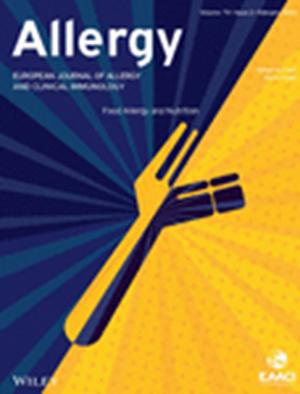Fish Allergenicity Ladder and Parvalbumin Epitopes for Predicting Clinical Cross-Reactivity and Reintroduction in Chinese Population.
IF 12.6
1区 医学
Q1 ALLERGY
引用次数: 0
Abstract
BACKGROUND IgE-mediated fish allergy has long been considered an umbrella term due to the high cross-reactivity of parvalbumin, the major fish allergen. Yet, clinical tolerance to certain fish highlights allergenicity differences. In this study, we sought to construct a fish allergenicity ladder and identify fish parvalbumin epitopes to improve the diagnosis of fish allergy. METHODS Reported clinical history and the serum-specific IgE (sIgE) responses of 200 Chinese subjects with suspected fish allergy were collected and analyzed, while the relative parvalbumin content in different fish was measured for the construction of a fish allergenicity ladder. Double-blind placebo-controlled food challenge (DBPCFC) and open challenge against salmon, grass carp, and grouper were performed in 58 selected patients for validation of the ladder. Epitope mapping was performed by peptide array against parvalbumins of salmon (both β-1 and β-2), cod, grouper, and grass carp with sera from fish allergic (n = 11), partial fish tolerant (n = 12), and complete fish tolerant (n = 5) patients diagnosed based on oral food challenge outcome. RESULTS The distribution pattern of reported history of fish allergy and tolerance, sIgE and molecular data, as well as their strong positive correlation led to the construction of a 3-step fish allergenicity ladder comprising: step 1 of the least allergenic fishes (tuna, halibut, salmon and cod), steps 2 of moderately allergenic fishes (herring and grouper) to step 3 of highly allergenic fishes (catfish, grass carp and tilapia). Epitope mapping revealed one epitope from grouper parvalbumin (AA64-78) for diagnosing general fish allergy and one epitopic region from salmon parvalbumin (AA19-33) as a biomarker of specific fish tolerance. Only epitope-specific IgE differentiated these patients but not sIgE to fish extract or parvalbumin. CONCLUSION The fish ladder and epitopes discovery can precisely differentiate fish-allergic and tolerant subjects and guide fish reintroduction by stepping up the ladder, which innovates fish allergy care in the next millennium.鱼类变应原性阶梯和小白蛋白表位预测中国人群的临床交叉反应和重新引入。
由于主要的鱼类过敏原小白蛋白的高交叉反应性,dige介导的鱼类过敏一直被认为是一个总称。然而,临床对某些鱼类的耐受性突出了过敏原的差异。在本研究中,我们试图构建鱼类过敏原阶梯,并鉴定鱼类小蛋白表位,以提高对鱼类过敏的诊断。方法收集200例中国疑似鱼类过敏者的临床病史和血清特异性IgE (sIgE)反应,测定不同鱼类的相对小白蛋白含量,构建鱼类过敏阶梯。在58名选定的患者中进行了双盲安慰剂对照食物挑战(DBPCFC)和对鲑鱼、草鱼和石斑鱼的公开挑战,以验证该阶梯。通过肽阵列对鲑鱼(β-1和β-2)、鳕鱼、石斑鱼和草鱼的小蛋白进行表位定位,并对根据口服食物挑战结果诊断的鱼过敏(n = 11)、部分鱼耐受(n = 12)和完全鱼耐受(n = 5)患者的血清进行检测。结果根据鱼类过敏和耐受史、sIgE和分子数据的分布规律及其强正相关关系,构建了三级鱼类过敏原阶梯:第1级为最低过敏原鱼类(金枪鱼、大比目鱼、鲑鱼和鳕鱼),第2级为中等过敏原鱼类(鲱鱼和石斑鱼),第3级为高过敏原鱼类(鲶鱼、草鱼和罗非鱼)。表位定位显示,一个表位来自石斑鱼小白蛋白(AA64-78),可用于诊断一般鱼类过敏;一个表位区域来自鲑鱼小白蛋白(AA19-33),可作为鱼类特异性耐受的生物标志物。只有表位特异性IgE能分化这些患者,而对鱼提取物或小白蛋白没有IgE。结论鱼类阶梯和表位的发现可以精确区分鱼类过敏和耐受对象,并通过阶梯的提升来指导鱼类的重新引入,这将是下一个千年鱼类过敏护理的创新。
本文章由计算机程序翻译,如有差异,请以英文原文为准。
求助全文
约1分钟内获得全文
求助全文
来源期刊

Allergy
医学-过敏
CiteScore
26.10
自引率
9.70%
发文量
393
审稿时长
2 months
期刊介绍:
Allergy is an international and multidisciplinary journal that aims to advance, impact, and communicate all aspects of the discipline of Allergy/Immunology. It publishes original articles, reviews, position papers, guidelines, editorials, news and commentaries, letters to the editors, and correspondences. The journal accepts articles based on their scientific merit and quality.
Allergy seeks to maintain contact between basic and clinical Allergy/Immunology and encourages contributions from contributors and readers from all countries. In addition to its publication, Allergy also provides abstracting and indexing information. Some of the databases that include Allergy abstracts are Abstracts on Hygiene & Communicable Disease, Academic Search Alumni Edition, AgBiotech News & Information, AGRICOLA Database, Biological Abstracts, PubMed Dietary Supplement Subset, and Global Health, among others.
 求助内容:
求助内容: 应助结果提醒方式:
应助结果提醒方式:


